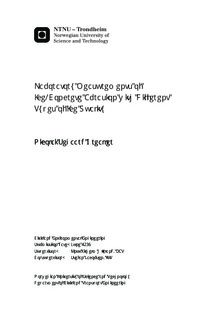Laboratory Measurements of Ice-Concrete Abrasion with Different Types of Ice Quality
Master thesis
Permanent lenke
http://hdl.handle.net/11250/233032Utgivelsesdato
2014Metadata
Vis full innførselSamlinger
Sammendrag
Ice-concrete abrasion has been investigated by review of lab- and field studies and by laboratory testing. The specific objective of this thesis has been to investigate the possible effects of different ice qualities on laboratory ice-concrete abrasion tests. This has been done by altering the ice parameters and keeping other test conditions constant.Five procedures have been developed to produce ice with differing qualities. Thin sections from each pro-cedure have been investigated and showed distinguishable ice texture. Large grains with vertical growth were observed for ice made in FRYSIS, a water tank located at NTNU. Small grain sizes and ice texture similar to that of sea ice was seen for ice made by freezing water in a plexiglas tube at -20 °C and blended with slush. Ice density and porosity was measured by applying Archimedes law, with cooled kerosene used as fluid. The highest porosity was measured for ice samples made by freezing carbonated water in a sealed tube, φ = 17.0 %. The lowest porosity was measured for the ice samples made in FRYSIS, φ = 0.9 %.Earlier studies on ice-concrete abrasion have been reviewed and have shown that test set-up conditions and results are varying. It has been concluded that in order to obtain results with a satisfying accuracy, concrete samples should be abraded to a minimum depth of 0.05 mm The measurement set-up for measuring abrasion depth was investigated and concluded to be repeatable. Of the two presented methods to calculate abrasion rate, it was concluded that referring ice exposed grid points to their nearest reference point was the most accurate. The abrasion rates obtained from the five different ice procedures varied in the same range as the abrasion rates for different concrete samples. Mean abrasion rate measured in this thesis varied in the range ≈ 0.02 - 0.07 mm/km. Lowest mean abra-sion rate was measured for ice that did not crush during the abrasion test. Highest abrasion rate was meas-ured for the ice made in FRYSIS, (0.086 ± 0.086) mm/km.
